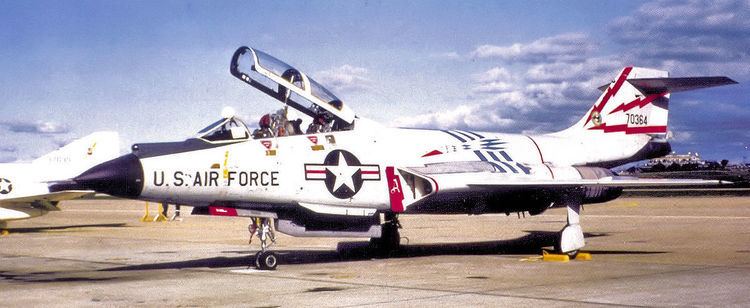 | ||
Active 1942–1946; 1946-1949; 1951-1964; 1966-1967; 1969-1983 Role Command of air defense forces Decorations Air Force Outstanding Unit Award | ||
The 21st Air Division (21st AD) is an inactive United States Air Force organization. Its last assignment was with Tactical Air Command, being stationed at Griffiss Air Force Base, New York. It was inactivated on 23 September 1983.
Contents
World War II
Initially established in 1942 as the 21st Bombardment Wing, the organization functioned as a staging wing for Second Air Force, and later as a command, processing heavy bombardment crews and aircraft for overseas movement, and then processing men returning from overseas, from 1942–1946.
Air Force Reserve
From December 1946, it performed routine training duties in the Air Force Reserve through 27 June 1949 when it was inactivated due to budget reductions.
Strategic Air Command
Reactivated as an intermediate command echelon of Strategic Air Command in February 1951 at Forbes Air Force Base, Kansas. The 21st Air Division controlled B-47 Stratojet medium bombardment wings at Forbes and Lake Charles Air Force Base, Louisiana. It was responsible for aircrew training, bomber replacement crews, and replacements for strategic reconnaissance slots until September 1964 when the B-47 was phased out of the inventory.
Air Defense Command
The command was reactivated by Air Defense Command (ADC) in January 1966 at McGuire Air Force Base, New Jersey as one of ten new Air Divisions organized by the command to replace inactivating Air Defense Sectors in an organizational realignment. Assumed additional designation of 21st NORAD Region after activation of the NORAD Combat Operations Center at the Cheyenne Mountain Complex, Colorado and reporting was transferred to NORAD from ADC at Ent Air Force Base in April 1966.
Under ADC the 21st AD was placed under First Air Force and assumed the jurisdiction of the former New York Air Defense Sector, controlling interceptor and radar units over eastern Pennsylvania, New Jersey, the New York City/Long Island area and the coast of Connecticut, Rhode Island and Massachusetts, including Cape Cod. This included operations of the Semi Automatic Ground Environment (SAGE) blockhouse DC-01. For operational control the division was also the 21st NORAD/CONRAD Region.
During this time, it participated in air defense training exercises, accomplished live and simulated intercepts, and directed numerous flying sorties until inactivation in December 1967 as part of an ADC consolidation of intermediate level command and control organizations, driven by budget reductions required to fund USAF operations in Southeast Asia.
The 21st AD was reactivated in November 1969 under Aerospace Defense Command (ADCOM) at Hancock Field, New York. The command provided air defense over most of Pennsylvania, New Jersey, New York and the New England area, commanding interceptor and radar stations. Also included were ADCOM radar stations located in Newfoundland, Canada. In addition command of the SAGE DC-03/CC-01 blockhouse was assumed by the 21st AD, as well as CIM-10 Bomarc surface-to-air anti-aircraft missile squadrons near Otis Air Force Base, Massachusetts, Niagara Falls Air Force Missile Site, New York and McGuire Air Force Base, New Jersey.
In 1975, a new JCS Unified Command Plan designated Air Defense Command as a specified command and changed its name to the Aerospace Defense Command (ADCOM) on 1 July 1975. The division assumed additional designation 21st ADCOM Region for operational control on 8 December 1978. Air Defense ADCOM was reorganized on 1 October 1979. The atmospheric defense resources (interceptors and warning radars) of ADCOM. including the 21st AD were reassigned to Tactical Air Command (ADTAC). It moved to Griffiss Air Force Base, New York in 1983 when Hancock Field was closed.
In 1983, when the air defense mission of CONUS was reassigned to the Air National Guard, the 21st Air Division (ADTAC) was inactivated and its assets transferred to Northeast Air Defense Sector.
Lineage
Stations
World War II
Strategic Air Command
Air Defense Command
Fighter-Interceptor units
Missile units
Radar units
Air Base units
Emblem
The Division's emblem consists of a Shield divided by a diagonal line from the upper right to middle left, light blue and white, a sword slanting from upper left to lower right, the point to lower right base, the hilt and pommel yellow encircled with five stars, yellow, the lower blade of the sword over a branch of olive in base green. (Approved 17 July 1952)
